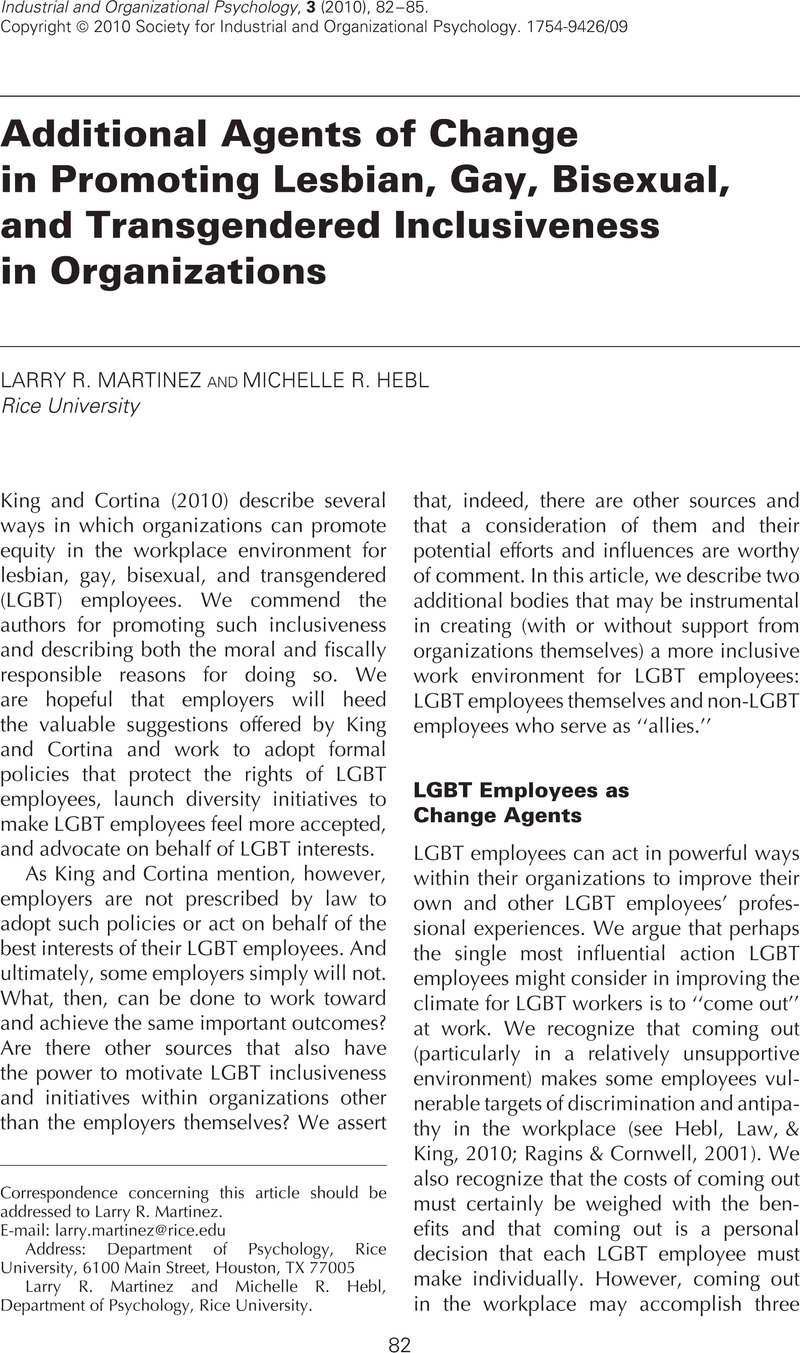Crossref Citations
This article has been cited by the following publications. This list is generated based on data provided by Crossref.
King, Eden B.
and
Cortina, José M.
2010.
Stated and Unstated Opportunities and Barriers to Lesbian, Gay, Bisexual, and Transgendered Supportive Organizations.
Industrial and Organizational Psychology,
Vol. 3,
Issue. 1,
p.
103.
Willis, Paul
2012.
Witnesses on the periphery: Young lesbian, gay, bisexual and queer employees witnessing homophobic exchanges in Australian workplaces.
Human Relations,
Vol. 65,
Issue. 12,
p.
1589.
Melton, E. Nicole
and
Cunningham, George B.
2014.
Who Are the Champions? Using a Multilevel Model to Examine Perceptions of Employee Support for LGBT Inclusion in Sport Organizations.
Journal of Sport Management,
Vol. 28,
Issue. 2,
p.
189.
Ozeren, Emir
2014.
Sexual Orientation Discrimination in the Workplace: A Systematic Review of Literature.
Procedia - Social and Behavioral Sciences,
Vol. 109,
Issue. ,
p.
1203.
Melton, E. Nicole
and
Cunningham, George B.
2014.
Examining the Workplace Experiences of Sport Employees Who Are LGBT: A Social Categorization Theory Perspective.
Journal of Sport Management,
Vol. 28,
Issue. 1,
p.
21.
Lewis, Nathaniel M
and
Mills, Suzanne
2016.
Seeking security: Gay labour migration and uneven landscapes of work.
Environment and Planning A: Economy and Space,
Vol. 48,
Issue. 12,
p.
2484.
Dahling, Jason J.
Wiley, Shaun
Fishman, Zachary A.
and
Loihle, Amber
2016.
A stake in the fight: When do heterosexual employees resist organizational policies that deny marriage equality to LGB peers?.
Organizational Behavior and Human Decision Processes,
Vol. 132,
Issue. ,
p.
1.
Smith, Ian P.
and
McCarthy, Grace
2017.
The Australian corporate closet: Why it's still so full!.
Journal of Gay & Lesbian Mental Health,
Vol. 21,
Issue. 4,
p.
327.
Martinez, Larry R.
Hebl, Michelle R.
Smith, Nicholas A.
and
Sabat, Isaac E.
2017.
Standing up and speaking out against prejudice toward gay men in the workplace.
Journal of Vocational Behavior,
Vol. 103,
Issue. ,
p.
71.
Ng, Eddy S.
and
Rumens, Nick
2017.
Diversity and inclusion for LGBT workers: Current issues and new horizons for research.
Canadian Journal of Administrative Sciences / Revue Canadienne des Sciences de l'Administration,
Vol. 34,
Issue. 2,
p.
109.
Tayar, Mark
2017.
Ranking LGBT inclusion: Diversity ranking systems as institutional archetypes.
Canadian Journal of Administrative Sciences / Revue Canadienne des Sciences de l'Administration,
Vol. 34,
Issue. 2,
p.
198.
Pichler, Shaun
and
Holmes IV, Oscar
2017.
An investigation of fit perceptions and promotability in sexual minority candidates.
Equality, Diversity and Inclusion: An International Journal,
Vol. 36,
Issue. 7,
p.
628.
Hennekam, Sophie A.M.
and
Ladge, Jamie J.
2017.
When lesbians become mothers: Identity validation and the role of diversity climate.
Journal of Vocational Behavior,
Vol. 103,
Issue. ,
p.
40.
Hur, Hyunkang
2020.
The role of inclusive work environment practices in promoting LGBT employee job satisfaction and commitment.
Public Money & Management,
Vol. 40,
Issue. 6,
p.
426.
Knowlton, Karren
Carton, Andrew M.
and
Grant, Adam M.
2022.
Help (Un)wanted: Why the most powerful allies are the most likely to stumble — and when they fulfill their potential.
Research in Organizational Behavior,
Vol. 42,
Issue. ,
p.
100180.
Wang, Jianrong
Anand, Smriti
Li, Hui
and
Du, Wei
2022.
Marriage equality for everyone? The business case for same sex marriage legislation.
Journal of Business Research,
Vol. 148,
Issue. ,
p.
190.
Anand, Smriti
Wang, Jianrong
Li, Hui
and
Du, Wei
2022.
Boon or Bane? The Business Case for Marriage Equality.
SSRN Electronic Journal ,
Noronha, Ernesto
Bisht, Nidhi S.
and
D’Cruz, Premilla
2022.
From Fear to Courage: Indian Lesbians’ and Gays’ Quest for Inclusive Ethical Organizations.
Journal of Business Ethics,
Vol. 177,
Issue. 4,
p.
779.
Pham, Quan Thuong
Le, Hung Quang
Mai, Khuong Ngoc
and
Phan, Anh Trieu
2023.
The effects of female sexually fluid workplace romance on their work and life.
Equality, Diversity and Inclusion: An International Journal,
Vol. 42,
Issue. 1,
p.
87.
King, Eden
Hebl, Mikki
Corrington, Abby
Dhanani, Lindsay
Holmes, Oscar
Lindsey, Alex P.
Madera, Juan
Maneethai, Dustin
Martinez, Larry
Ng, Eddy S.
Nittrouer, Christine L.
Sabat, Isaac
Sawyer, Katina
and
Thoroughgood, Christian
2024.
Understanding and Addressing the Health Implications of Anti-LGBTQ+ Legislation.
Occupational Health Science,
Vol. 8,
Issue. 1,
p.
1.



